Familiarity with the collectors of nuclear weapons
As researchers study nuclear weapons?

Richard Rhodes in his book “the Creation of the atomic bomb,” wrote that able to release the tremendous energy of the atom is no less important than the discovery of fire.
It was a landmark moment in the development of human civilization, radically changed the nature of international relations. If a nuclear bomb to detonate in the major cities, millions will die from the shock wave and fires, and the release of radioactive materials. The exchange of blows between the countries owning such a destructive force, guarantees the destruction of humanity, and given the power of weapons and of the planet itself. It is therefore not surprising that many have become avid collectors and researchers of the history of nuclear weapons.
According to the historian of the nuclear scientist from the Institute of Technology Stevens Alex Wellerstein, these people are divided into two groups. The first consists of enthusiastic nuclear technology in General — for them it is an informal hobby-hobby. The second group – those who are serious about developing nuclear weapons. It’s not random people that collect information on the Internet, and activists of anti-nuclear projects. Many seek to remove the secrecy from the research in the field of atomic weapons.
Alex Wellerstein notes that both groups are interesting, but they have different goals. According to him, among the activists meet scientists, visual artists, miners, collectors, researchers, truck drivers, artists, writers, and students. Regardless of personal motives, these people have similar traits, linked and driven by a single goal.
A unique exhibition “a Thousand suns”
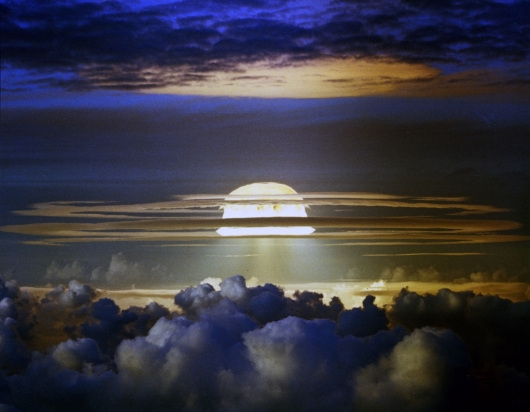
The sunset, the explosion of a 1 megaton (1962), photographed from the plane.
Alexander Mikhalchenko wanted to show that nuclear explosions are different. He argues that there is no identical snowflakes, there is no identical nuclear explosions. At the age of 14 he began collecting photography, which depicted the liberation of enormous energy. Prologue to the beginning hobby became a dispute with a classmate about what the most powerful explosions – nuclear or hydrogen.
Eight years comparison of images of Alexander came to the conclusion that the hydrogen bomb more powerful. In addition, it gathered the biggest in Russia private collection of photographs of nuclear explosions. In December 2017 the Moscow Multimedia art Museum (MAM) officially recognized the scope of the collection. Based on the photo of Alexander was organized the exhibition “a Thousand suns”. It is dedicated to nuclear testing 1946-1962 years in the United States.
Image not classified — the majority has the status of heritage to the public, but a photo was not published and was not present earlier. Besides the historical value, the images allowed the scientists to assess nuclear warheads and test results. They also helped to measure the energy released during detonation, that is the power of the explosion. The researchers used the pictures to study the characteristics of the weapon (the process of forming a radiation cloud) and check the calculations.
Truly an extraordinary exhibition made by the author. Surprisingly, with the level of qualification in the field of nuclear energy Alexander managed to gather such a large collection. The collection of photographs started in 2012. While Mikhalchenko was unknown Moscow guy that knew little English. The collector has raised suspicions by sending requests for the images of nuclear explosions. Alexander became the founder of the theme of the blog NUKES in VK, but was not widely known to the Internet community, as more had of online resources in the network. Today Mikhalchenko spends a few hours a day to study the images.

Oak Hardtack, the explosion of the 8.9 megaton (1958)
The exhibition presents a variety of photos, arranged in chronological order. They were selected on the basis of scientific and historical significance imprinted trials. The exhibition includes five sections:
1. The first nuclear test.
2. Testing in the Pacific.
3. High-altitude nuclear explosions.
4. The explosions at the nuclear test site in Nevada.
5. Pictures from the Rapatronic camera images showing the reaction of Americans to nuclear explosions. They are made before the signing of the Treaty with the Soviet Union in 1963.
The document banned the testing of nuclear weapons in the atmosphere, space and under water. Respectively, exclude the possibility of photographic images of explosions in these environments.
The exhibition presents many rare or previously unpublished images. The exhibition includes the children participating in the exercise (they are hiding from the flash, appeared on the horizon) and a radioactive cloud the size of a city.

Presents photographs are so realistic that they seem not real. The impression is that they are made with modern cameras able to capture moments with a frequency of several milliseconds. In fact, the image appeared in the period of the arms race that began after the Second world war.
In 1949 the Soviet Union exploded first atomic bomb, which marked the era of a bipolar nuclear confrontation. The governments of the warring parties has invested heavily in the development of super destructive weapons. Until the end of the cold war in 1987, residents of most parts of the world were under threat of total destruction. About that troubled time recalled by the exhibition, although recent geopolitical events have returned to humanity in the era of total fear.
Photo exhibition focused on the explosions, their cultural impact, so none of them gives a presentation about the devastating impact on the cities of Hiroshima and Nagasaki and who lived in them. In the book “the Creation of the atomic bomb” (awarded the Pulitzer prize) Richard Rhodes devotes no less than 19 pages to eyewitnesses of the devastation in Hiroshima. These are stories of men, women and children, with which the skin is peeled off like a rubber glove from a hand.
The exhibition “a Thousand suns” is not shown mass human suffering. This allows content created by the US government, to preserve ideological content.

As promised, the experts in the field of nuclear weapons believe that their work is based on the desire to make a serious issue more understandable. “My goal personally is to people considered the atomic bomb” – said Wellerstein, expressing concern that many consider the use of nuclear weapons is akin to the Apocalypse that may never come.
According to him, the problem is in the erroneous perception of such weapons. Exchange of blows will turn the whole world into a toxic desert in less than three hours to free the people from responsibility in the effort to survive among the radioactive ruins of the city. “You don’t write to the authorities about the death of the planet from the shock wave and radiation – things that are beyond the control of the person, but send letters, if you need to fix metro. By placing the problem of an atom in a category daily, you can gain massive interest,” notes Alex.
For the correct perception…

In an effort to better understand the problem Wellerstein together with Christine Karl (associate Professor of political science of Stevens Institute of Technology) established the project “Inventing civil defense.” It aims to develop strategies for communicating nuclear risks by funding creative initiatives.
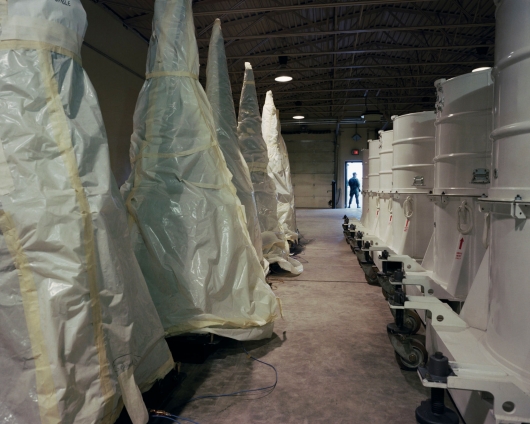
For example, the website NUKEMAP Wellerstein gives the possibility to simulate a nuclear explosion anywhere in the world. This is a realistic simulation of the effects of the use of destructive weapons. Users choose the basic parameters of the bombing, for example, environment applications: air, earth, ocean. Next are calculated and visualized all measurable effects associated with the use of bombs.

It is understandable why the image of Wallerstein are educational content and not the legendary photo of the fireball formed first dropped on the city a nuclear warhead. The scientist says it is the most popular pictures that are often published, but don’t show the problem fully.
Alex selects a photo in the exhibition Mikhalchenko, which captures the explosion Fizeau in Los Alamos. The scientist says that the is a clear demonstration of nuclear terror. Also commendable series of “Nuclear weapons” Floor Sambrama created in 1992-2001 year. Here Alex allocates soldier swept the floor around the nuclear gravity bomb the B83. According to the scientist, this is the most impressive demonstration of beauty and boredom, which helps people to form their own attitude to weapons of the Apocalypse.
To look behind the veil of secrecy
Like Mikhalchenko, Shambroom daily hours studied policy in the field of armaments. He appealed to the government to get permission to photograph at sites where access is restricted. His images show the bunkers and weapons that were previously classified. The author himself says that many are obsessed with the idea of visiting such objects, so his book rasprodala for a few hours after the release in 2003.
Ordinary truck driver John Coster-Mullen drove across the country in search of artifacts that would help to restore the original atomic bomb. His work has led, inter alia, to the publication of a book entitled “the Atomic bombs: top secret story about the little boy and fat man”. John calls himself a “nuclear archaeologist” – he conducts interviews, collects documents, explores the polygons in order to create an exact duplicate of the atomic bomb.
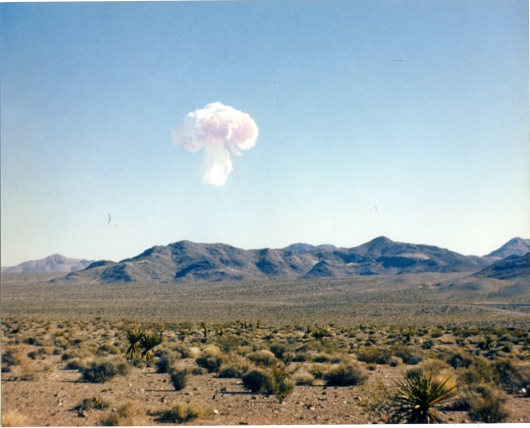
The Amateur archaeologist considers his work complete. According to John, he learned all about the first two nuclear warheads created in the USA. In 2015, the former Director of the weapons Division at Los Alamos national library, the John S. Hopkins, accused John Koster-Mullen in violation of the Treaty on the nonproliferation of nuclear weapons (NPT).
On this charge was not litigation, but the Amateur archaeologist says that now the employees of Los Alamos national laboratory is no longer going to contact him — John says that they recommend to remain silent.
Coster-Mullen not the one who was accused of distributing classified materials. Peter Kuran, the artist, who on the basis of a visual effects shot in the 1995 film “Trinity and beyond: a film about the atomic bomb”, came in sight of the officials. The authorities asked how it was possible to place the film so a lot of secret scenes. But as Coster-Mullen, Peter Kuran took material from unclassified sources. According to the artist, the government immediately removes from sharing what you need to keep secret. Else – publicly available materials that are left turn into secret image.
Turning to the Ministry of defence, Ministry of energy and National nuclear security administration for comment on the words of the Koran pokeno Peter was the official explanation. The representative Nolan O’brien reported that personnel are removed not because I want to officials — Video and photo withdrawn from public access in accordance with the classification system, which is regulated by law. Such materials are intended for business use only.

Operation HARDTACK-Teak (1958). Exclusive collection of photographs of high-altitude bombing TEAK, 3.8 megatons at an altitude of 76 km. the View from Hawaii. It was a night light show in the sky – we see a fireball of gigantic size because of the sparse atmospheric conditions (thin air)
Nolan O’brien said, according to what criteria selected the pictures, as they are classified as “Secret”. But Peter Kuran explained that some photos are used to measure parameters of the explosion, and if you do not know about it, the image perceived as beautiful pictures. It used them an artist to create a movie. This was due to the desire to present to the audience the most realistic product.
The desire to get closer to the original led John Coster-Mullen to the study of long 25 years, Alexander Mikhalchenko — collection of photo collection. Some enthusiasts are not afraid of working with uranium is a radioactive material.
Natural uranium is not dangerous. According to Wallerstein, it is weakly radioactive and chemical toxicity harm to health before the radiation. The scientist says that you can buy uranium on eBay. Another option to acquire radioactive material – contact the community builders uranium.
Bewitching power
According to author and historian Richard Rhodes, the desire to obtain the element of a nuclear bomb is connected with indescribable sensations. Is the embodiment of cosmic power, which cannot be seen in everyday life. And there is the possibility to touch its source. Rhodes also claims that people working with uranium, feel a sense of power and control.
This is what inspired the artist and scientist Jim Sanborn. He again reproduced the original splitting of the uranium atom, all of the types of radioactive materials used in different projects.
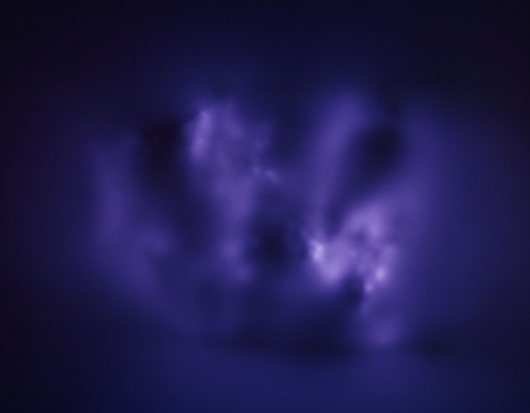
Jim Sanborn, “the Gas hills, Wyoming, 2001-2003”, the uranium autoradiograph, digital print, 30 x 36 inches.

Jim Sanborn, “Joachimsthal, Bavaria, 2001-2003”, the uranium autoradiograph, digital print, 30 x 36 inches.
Research Sanborn led to the establishment of contacts with nuclear scientists, miners, mining the uranium, the people who collected materials about the work of loved ones over the creation of nuclear weapons. Reconstruction of the hall of Assembly of the first nuclear charge made Jim contact with many scientists involved in the project. It was necessary to collect merchandise, sold by the government after the removal of secrecy. Many things are acquired by those who worked to create a nuclear bomb.
Workers of different professions often collect memorabilia from work, but the number of people brought home hazardous materials, unusually large. Sanborn spoke about the miner, whom she met during the search of a closed uranium mining facility. The fence of his house was decorated with bright yellow stones. Jim says that it was uranium 235. In Wisconsin scientist met a man who dekorirovaniya his daughter’s room cores of depleted uranium ammunition.
The artist, an expert on nuclear polygons Eric Lopresti says that the bright glow of the material and its unique properties allow idealizing technical progress. So, scientists who developed the atomic bomb, hoped to put an end to wars, and the creation of the Internet was conceived as a relief and improvement of human life. In both cases idealism has overshadowed the ability to assess risks associated with these large-scale achievements. “As an artist, I think the first step is to avoid global catastrophes – a clear understanding of the risks,” said Eric.

This view corresponds to Mikhalchenko, Wallerstein and Koran that also talk about the need to show the problem in a new light. Rhodes argues that we should change the perception of nuclear weapons in the street. But the scale of the action enthusiasts and activists too small. Whether the photo is a motivator for mankind to greater control of nuclear weapons? And if so, how many people want to see images of devastating explosions, or read books on the issue? What impact it finally has?
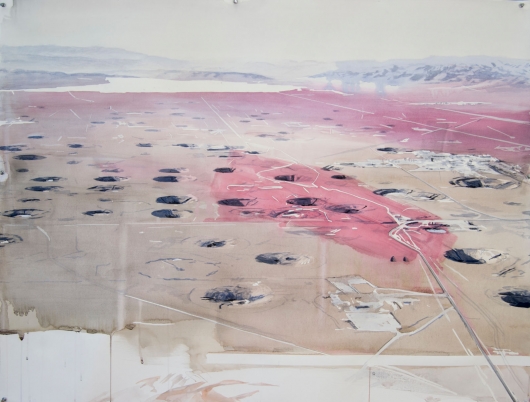
Two years ago most Americans did not know that the United States possess nuclear weapons. Recent disagreements between the United States and North Korea changed the situation. According to a study conducted by Chapman University in 2016, citizens are more afraid of the “law of available assistance” than the threat of nuclear war. Is it just the risk of a real destruction of mankind is able to draw public attention to such a clear and imminent danger, as nuclear warheads?
